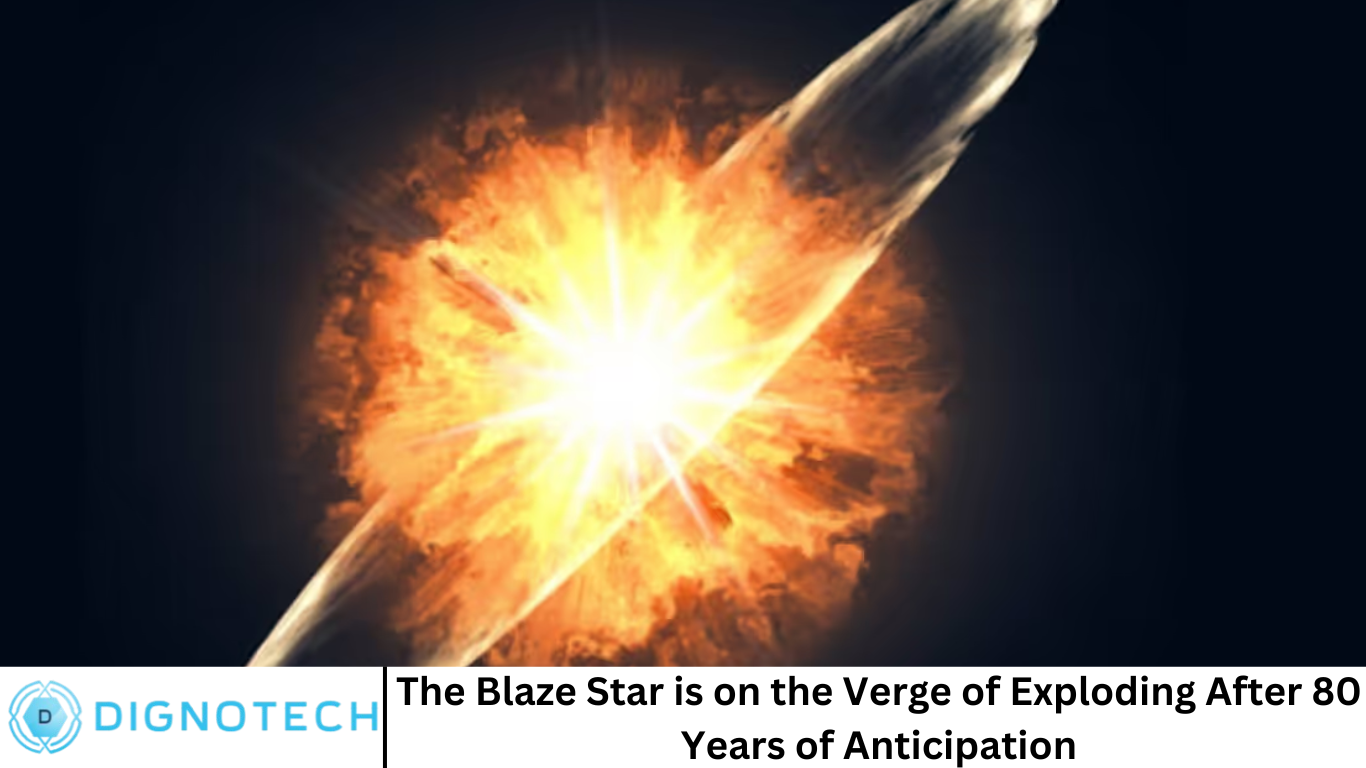The Blaze Star is on the Verge of Exploding After 80 Years of Anticipation

Hi everyone! How are you all doing? Welcome to dignotech.com! For nearly 80 years, the Blaze Star has captivated the imagination of astronomers, astrophysicists, and stargazers alike. Its dramatic transformation into a supernova is one of the most awaited cosmic events, offering a glimpse into the final stages of a massive star’s life. Situated hundreds of light-years away, this extraordinary star’s eventual explosion will not only provide valuable insights into stellar evolution but also help scientists better understand the universe’s mechanics. In this article, we explore the fascinating journey of the Blaze Star, its impending supernova explosion, the science behind such events, and the broader implications for both space research and the future of our universe.
Understanding The Blaze Star
The Blaze Star, also known as Betelgeuse, is a red supergiant star located in the constellation Orion. One of the brightest stars visible in the night sky, Betelgeuse has long been a subject of interest for astronomers. It is around 650 light-years away from Earth and is the 10th-brightest star in the sky. Although Betelgeuse appears relatively close, the vast distance still places it far enough to ensure that its eventual death will not have any direct impact on Earth. However, the event will mark a significant milestone in our understanding of stellar life cycles.
Betelgeuse is an old star. Estimated to be around 10 million years old, it is nearing the end of its life cycle. Stars like Betelgeuse begin their existence by fusing hydrogen into helium, creating immense amounts of energy. As the hydrogen in a star’s core is used up, it begins fusing heavier elements like helium into carbon, leading to a series of reactions that increase the star’s size and heat. In the case of Betelgeuse, this process has led it to expand into a massive red supergiant.
The Supernova Explosion
The impending explosion of Betelgeuse will occur when the star has exhausted its nuclear fuel and can no longer support its own gravity. In a red supergiant like Betelgeuse, once the core collapses, it triggers a violent and catastrophic explosion known as a supernova. This event is one of the most powerful forces in the universe, capable of outshining an entire galaxy for a brief period of time.
Supernovae are crucial to the creation of heavy elements like gold, uranium, and even the iron in your blood. During a supernova, the core of the star collapses into a dense neutron star or even a black hole, depending on the mass of the original star. The outer layers of the star are ejected at incredible speeds, enriching the surrounding interstellar medium with elements necessary for the formation of planets and new stars.
For Betelgeuse, the collapse of its core is imminent, and its explosion will be a spectacular sight. While its distance from Earth means we will not be in any immediate danger, the event will be observable from our planet. If Betelgeuse were to explode today, it would likely be as bright as the full moon, visible even in daylight.
80 Years of Anticipation
The 80 years of anticipation surrounding Betelgeuse’s supernova stem from the fact that supernovae do not occur overnight. Stars like Betelgeuse go through many stages before they finally explode. While scientists have known for decades that Betelgeuse was nearing the end of its life, the timing of the explosion remains unpredictable. It could happen within the next few thousand years, or it could take longer than that. The fact that Betelgeuse’s explosion has been “on the verge” for 80 years has kept astronomers eagerly awaiting the event, even though they cannot precisely pinpoint the timing.
In 2019, Betelgeuse began to exhibit unusual dimming, leading some scientists to speculate that the supernova might be imminent. This dimming was later determined to be caused by dust clouds around the star, not a precursor to an impending explosion. However, the event sparked renewed interest and discussion, as astronomers and the public alike had long been wondering when Betelgeuse would finally meet its end.
The Significance of Betelgeuse’s Supernova
The explosion of Betelgeuse will provide an invaluable opportunity for scientists to study supernovae up close. The event will allow astronomers to observe the final moments of a massive star’s life and study the processes that lead to its death. Researchers will be able to measure the types of elements ejected during the explosion, the intensity of the blast, and the behavior of the shockwaves as they travel through space.
Betelgeuse’s supernova will also help answer some of the most profound questions about the universe. For example, astronomers are still working to fully understand how stars like Betelgeuse collapse and trigger supernovae. Studying this process up close will provide more information about the physics of dying stars and help refine models of stellar evolution.
Another key area of research involves the detection of neutrinos. When a star explodes in a supernova, it releases an enormous number of neutrinos — subatomic particles that are notoriously difficult to detect. Studying these neutrinos will offer insights into the nature of these particles and the behavior of matter under extreme conditions.
What to Expect During the Supernova
If Betelgeuse explodes in the near future, it will be a remarkable event that will draw the attention of scientists and stargazers around the world. The explosion will likely be visible even during the day, casting a bright glow in the sky. The light from the explosion will reach Earth within hours or days, depending on the exact timing of the event.
Betelgeuse’s supernova will release an immense amount of energy, and while it will be visible to the naked eye, it will not pose any threat to Earth. The radiation from the explosion will not be strong enough to cause damage to life on our planet. However, the event will offer a once-in-a-lifetime opportunity for astronomers to study the remnants of the explosion and gather data about the star’s composition and the dynamics of the explosion.
After the explosion, Betelgeuse will leave behind a remnant, either a neutron star or a black hole, depending on the size of its core. This remnant will continue to influence the surrounding space for millions of years. The surrounding gas and dust expelled during the explosion will eventually contribute to the formation of new stars and planets.
The Impact of Betelgeuse’s Death on the Future of Astronomy
Betelgeuse’s supernova is just one of many similar events that occur throughout the universe. While Betelgeuse is one of the most famous stars expected to explode in the near future, it is far from the only one. The study of supernovae is essential for understanding the lifecycle of stars and the evolution of galaxies.
As astronomers continue to monitor Betelgeuse and other stars nearing the end of their lives, they are gaining valuable insights into the behavior of massive stars and the forces that govern their evolution. The study of supernovae also plays a crucial role in understanding the formation of black holes and neutron stars, as well as the cosmic processes that lead to the creation of heavy elements.
In the long run, Betelgeuse’s explosion will help expand our understanding of the universe, providing new clues about the origins of life, the formation of galaxies, and the ultimate fate of stars. The data gathered from this event could help us solve some of the most fundamental questions about the cosmos and shed light on phenomena that have long been mysterious.
Frequently Asked Question
What is Betelgeuse?
Betelgeuse is a red supergiant star located in the constellation Orion. It is one of the brightest stars in the night sky and is nearing the end of its life. Betelgeuse is about 650 light-years away from Earth and is expected to eventually explode as a supernova.
When will Betelgeuse explode?
The exact timing of Betelgeuse’s supernova is uncertain. It could explode at any time within the next few thousand years, but it is impossible to predict the exact moment of the explosion. Astronomers are closely monitoring the star for any signs of change.
Will Betelgeuse’s explosion affect Earth?
No, Betelgeuse’s explosion will not pose any threat to Earth. The star is located far enough away (around 650 light-years) that its explosion will not harm our planet, though it will be a spectacular sight in the night sky.
How will we observe Betelgeuse’s supernova?
Betelgeuse’s explosion will be visible from Earth with the naked eye. It will likely shine as brightly as the full moon, and it may even be visible during the day. The explosion will release an immense amount of light and energy.
What will happen to Betelgeuse after it explodes?
After Betelgeuse explodes, it will leave behind either a neutron star or a black hole, depending on the size of its core. The surrounding gas and dust will be expelled into space and will contribute to the formation of new stars and planets.
Why is Betelgeuse’s supernova important to scientists?
Betelgeuse’s explosion offers a unique opportunity for scientists to study the final moments of a massive star’s life. It will provide valuable data on supernova mechanics, the formation of heavy elements, and the behavior of neutron stars and black holes.
Will we be able to see Betelgeuse’s explosion?
Yes, Betelgeuse’s explosion will be visible to the naked eye, potentially appearing as bright as the full moon. It will be an extraordinary event that will capture the attention of astronomers and skywatchers around the world.
Conclusion
The impending explosion of Betelgeuse marks a monumental event in the life of this star and will be a significant milestone for the field of astronomy. With 80 years of anticipation building, the supernova of this red supergiant will provide astronomers with an unprecedented opportunity to study the death of a massive star in real-time. While we may not know exactly when the explosion will occur, when it does, the scientific and public interest will be extraordinary, revealing crucial information about the universe’s most mysterious and violent processes. Betelgeuse’s death will not only mark the end of a star’s life but will also serve as a new beginning for scientific discovery, offering fresh insights into the cosmos we continue to explore.





